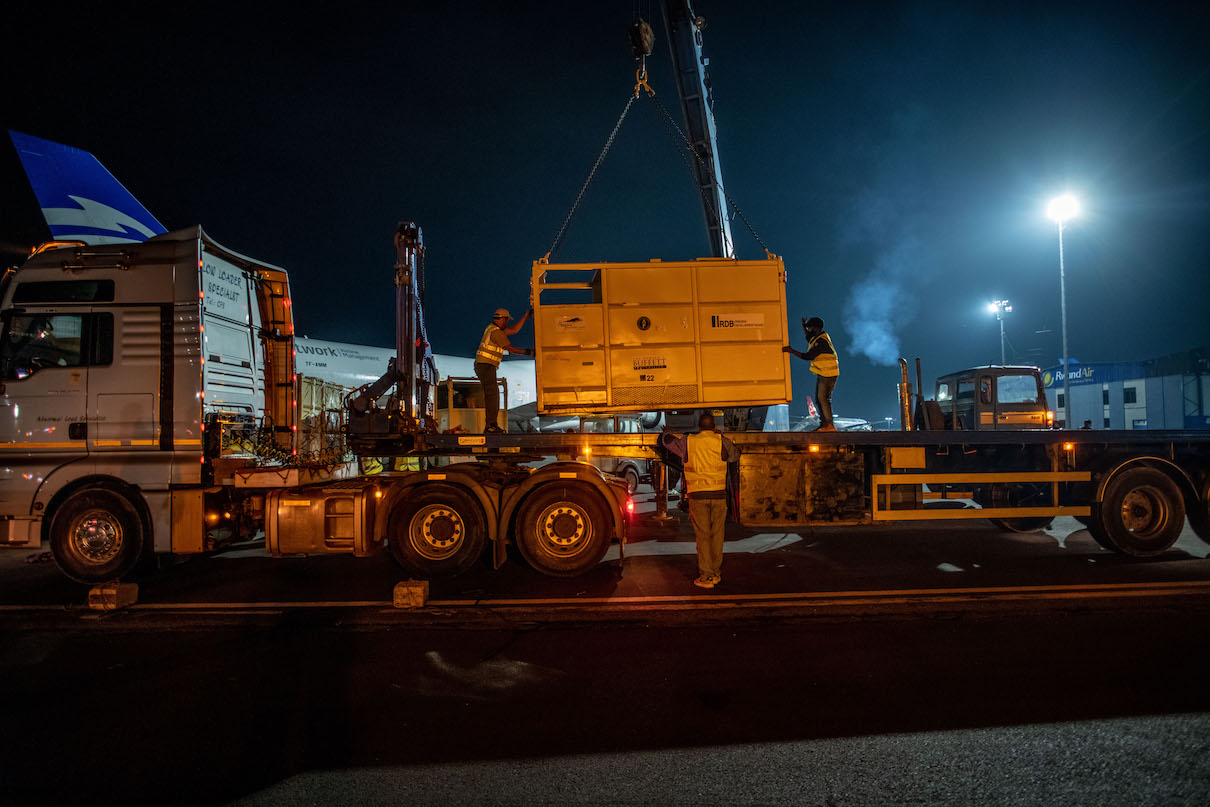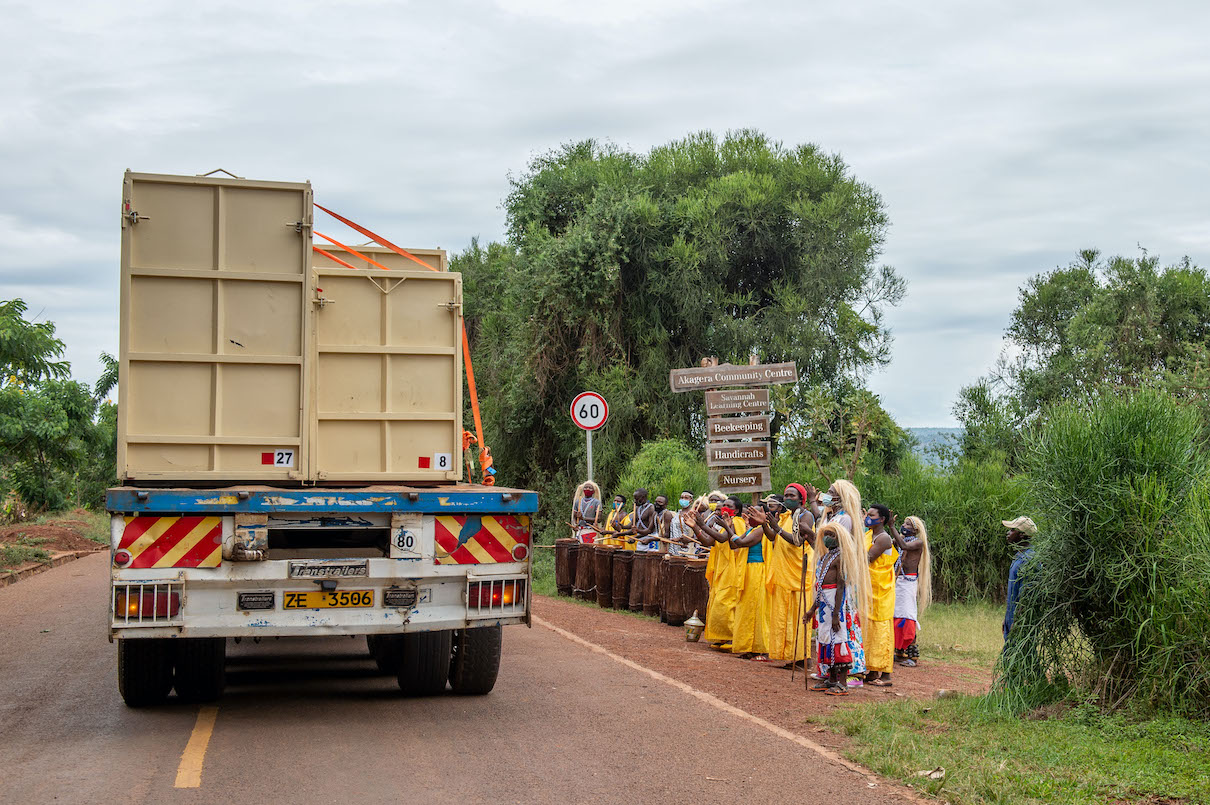- On Nov. 29, 30 white rhinos were introduced to Akagera National Park in Rwanda from a private game reserve in South Africa.
- The relocation is aimed at establishing the species in a new range state and ensuring its survival into the future.
- Akagera National Park has not had a single high-value animal poached for the past 11 years, and has become a sanctuary for other translocated species such as lions and black rhinos, according to the NGO African Parks, which helps to manage Akagera.
- White rhinos are considered a near threatened species that under continual threat from poaching incidents.
Traveling these days isn’t easy. When it involves moving 30 rhinos by air across a continent, it gets even trickier.
“Anything can change in seconds,” Jes Gruner, Rwanda regional operations manager, told Mongabay in a phone interview. “The aircraft charter delayed us by eight hours, unfortunately, due to technical issues. We already had the rhinos in the crates … but the team got together and sorted it very quickly.”
A delayed flight was just one of many challenges. Before the rhinos even got on the plane, Gruner and his team had worked for years to organize their translocation from South Africa to Rwanda, and recently battled COVID-19-related delays and setbacks. Then they had to figure out how to safely sedate the animals and get them into crates on a tight schedule. And once they arrived in Rwanda, the rhinos had to be loaded onto trucks and driven another six hours to Akagera National Park, a 1,120-square-kilometer (430-square-mile) stretch of wetlands, woodlands and savannas.
But when the trucks drove the 30 rhinos into the park on Nov. 29, Gruner knew the toil and stress had paid off.
“It’s a good feeling,” Gruner said. “When you’re driving through the communities, and they’re welcoming the rhinos and … showing they’re committed to conservation, it just makes all the work feel worthwhile. That’s a human-to-human feeling, but I wish the rhinos could feel that, too, because they are coming to a place where they truly are welcome.”

The 30 white rhinos (Ceratotherium simum) — 19 females and 11 males — were moved from the andBeyond Phinda Private Game Reserve in KwaZulu-Natal province, South Africa, in an effort to establish a new population in Rwanda that would help ensure the species’ survival into the future. This was the largest single translocation of the species, according to the NGO African Parks, which helps to manage Akagera.
White rhinos are currently considered to be a near threatened species by the IUCN, and their numbers continue to decrease due to illegal poaching for their horns, which are a sought-after commodity in traditional Chinese medicine.
One subspecies of the white rhino, the northern white rhino (C. s. cottoni), only has two individuals left in the world: a mother and daughter pair at Ol Pejeta Conservancy in Kenya. The other subspecies, the southern white rhino (C. s. simum), to which the 30 new Akagera residents belong, has a population of about 18,000 individuals across five primary countries: South Africa, Namibia, Kenya, Botswana and Zimbabwe.
“Their numbers are on a knife edge and they can go either way,” Gruner said. “So we really need to try and do our best to ensure that they go in the positive way.”
In 2010, African Parks and the Rwanda Development Board (RDB) helped reestablish Akagera National Park after the 1994 Rwandan genocide, which had nearly destroyed the park. Since then, the park has been transformed into a refuge for Rwanda’s wildlife, and according to African Parks, not a single high-value animal has been poached there for the past 11 years. The park has also acquired many translocated animals, including two lions (Panthera leo) in 2015, 18 critically endangered black rhinos (Diceros bicornis) in 2017, and another five black rhinos from European zoos in 2019. This latest translocation of white rhinos was a partnership between African Parks, RDB, andBeyond, and the Howard G. Buffett Foundation.

White rhinos have not been present in Akagera in recent history, so their introduction to the national park is a first step in creating a new range state for the species, according to Gruner.
Ladis Ndahiriwe, park manager for Akagera, said the national park was an ideal choice for the white rhinos because it provides a suitable and safe habitat for them.
“We have everything,” Ndahiriwe told Mongabay in a phone interview. “We’ve put everything in place: law enforcement, the security, we even made an assessment to see [that the appropriate] grass and food are here. I think it’s a perfect place to keep these animals, who are specifically in danger, because [Akagera is] very secure.”
Eugene Mutangana, head of conservation for RDB, said he expects this translocation to be as successful as previous ones, but said it will depend on how the white rhinos adapt to their new surroundings and if they reproduce.
“We are happy with the growth of the numbers of each species that we translocated, so we envision the same [for the white rhinos],” Mutangana told Mongabay in a video call. “We are confident that it will be a success in the coming years.”
Markus Hofmeyr, a member of the IUCN’s African Rhino Specialist Group who assisted with the rhino translocation as a wildlife veterinarian, says this move is significant since it could potentially help rhinos be reestablished in other areas in Rwanda besides Akagera.

“The key importance of Rwanda is that there is now a new settled population of white and black rhino in East Africa and if their numbers grow, then the Rwanda population can be a source of rhino for [other] areas regionally as more parks become available after recovery and securing to reintroduce rhino species into their historical range,” Hofmeyr told Mongabay in an email.
Gruner says the rhinos have been doing “really well” since their arrival in Akagera, and that the team will be closely monitoring their progress.
“They’re very, very calm and moving together,” Gruner says. “It’s looking really positive … but by no means are we safe and dry. We have a long way to go. I’d say 70% of the work is done. The other 30% now is making sure they really do acclimatize — but it’s looking positive.”
A dedicated team of rhino rangers and trackers will be keeping tabs on the new white rhino population to ensure their safety and monitor their health and behavior, says Drew Bantlin, conservation and research manager at Akagera. He added it’s not just security that has kept the park safe for so many years — it’s the support of the local communities.
“Our support from the communities is incredible,” Bantlin told Mongabay in a phone interview. “People are understanding why we’re operating and how it benefits [them].”
Banner image caption: One of the white rhinos released into Akagera National Park in Rwanda. Image by Gael Vande Weghe / African Parks.
Elizabeth Claire Alberts is a staff writer for Mongabay. Follow her on Twitter @ECAlberts.
FEEDBACK: Use this form to send a message to the author of this post. If you want to post a public comment, you can do that at the bottom of the page.
